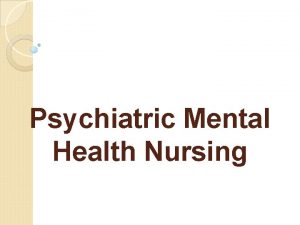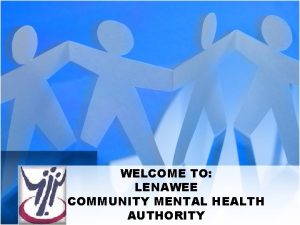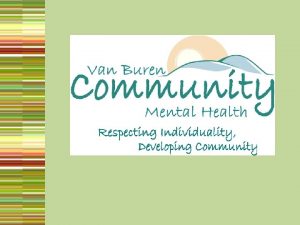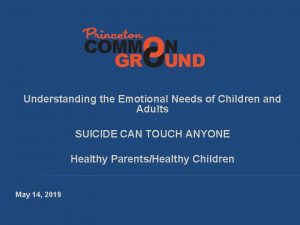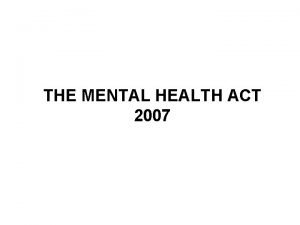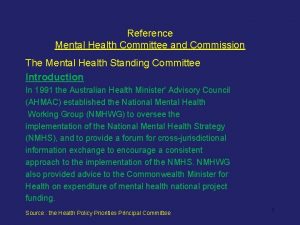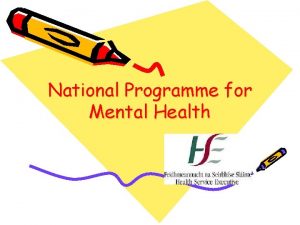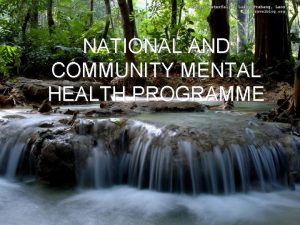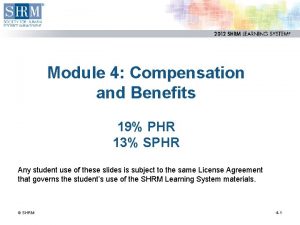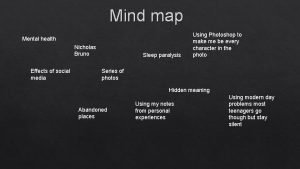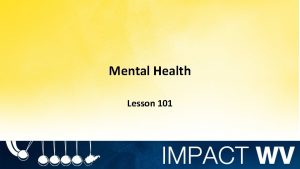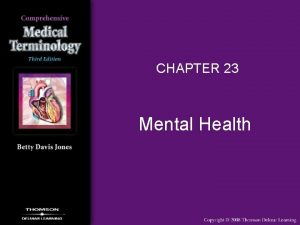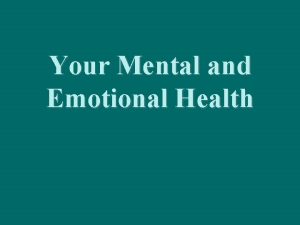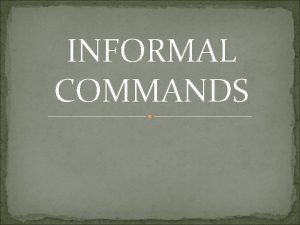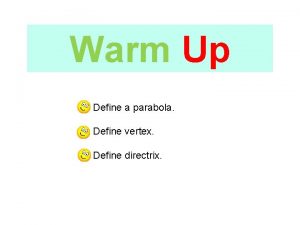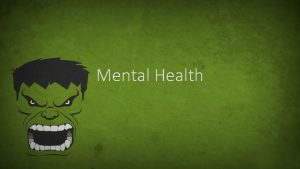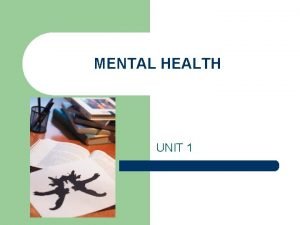Mental Health Unit DEFINE THE FOLLOWING n Mental































































- Slides: 63

Mental Health Unit

DEFINE THE FOLLOWING n Mental Health n Wellness n Personality n Stereotype n Self-Esteem

Mental Health The ability to express emotions and deal with the demands of daily life.

Characteristics of Good Mental Health n n n Sense of belonging Sense of purpose Positive outlook Self-Sufficiency Healthy Self-Esteem

Wellness The highest level of well-being achieved through lifestyle. How you choose to live your life

Personality n. How you think, feel and behave. Your personality can change throughout your lifetime. How? n 5 Minute

Stereotype n Thinking that all members of a specific group have the same traits, attitudes, characteristics, etc.

Self-Esteem How much you value, respect, and feel confidence in yourself. If you feel loved, valued, and accepted by others, and you love, value, and accept yourself, your overall attitude and outlook will be good! Letter to a person on their first day here

LIFE STAGES n n n Teenage Years (13 -19) Young Adulthood (20 -40) Middle Adulthood (40 -65) Late Adulthood (65 death)

Teenage Years n Puberty: PHYSICAL CHANGES marking the beginning the manhood/womanhood. n Girls n 12 Boys 14 Adolescence: Mental and social changes. n Three n Who (3) Key Questions asked… am I? n What do I believe in? n Where am I going?

THE PROGRESSION

Who Am I? n Attempt to discover your identity n Grow through activities and people n Desire to belong

What do I believe in? Values: Beliefs, rules or guidelines you feel are important to live by. Examples:

Where am I going? Making your own choices and setting goals.

Alien Exchange Program n n n You will be participating in an Alien Exchange Program. You will switch places with an extraterrestrial being, length of time T. B. D, but first you must educate them. You need to write a manual for the Alien about your life, who you are, what you value (what even are values? ? ) and what goals you have. Tell them about the ways of the world, people, and even this school and community. You need to complete this manual to be sure that the exchange program is a success.

Young Adulthood Go to college n Start careers n Reach emotional maturity n Make decisions and understand consequences n Marry/Family n

Middle Adulthood Reflect on life choices n Physically change n Retirement n Confront death n

Late Adulthood Some people experience a mental and/or physical breakdown. n Enjoy and relax family and friends n Confront death n


EMOTIONS Signals that tell your mind & body how to react. How you respond to these feelings can affect your level of wellness.

LOVE Strong affection, deep concern, and respect are expressions of love. Loving someone means you support the needs and growth of that person and respect the person’s feelings

TYPES OF LOVE n. Friendship: loyalty n. Family: unconditional n. Romantic: passionate n. Community: pride

Anger A normal reaction to being emotionally hurt or physically harmed. Anger can lead to violence. Hostility is the intentional use of unfriendly or offensive behavior.

Fear The belief that someone or something is dangerous, likely to cause pain, or a threat. Some people let fear of imagined threats prevent them from taking healthful risks.

n Fear of the unknown n Fear of losing someone/something you have n Fear you cannot get what someone else has n. An exaggerated, unrealistic fear

Grief: A deep feeling of sorrow caused by the loss of something you cannot get back

n Denial: refusing to believe it happened n Anger: frustration over the loss n Bargaining: Attempt to get it back n Depression: Realizing you can’t get it back n Acceptance: accept the loss and moves on

Happiness: A feeling of contentment and well-being

Empathy The ability to imagine and understand how someone else feels.

Managing your emotions Are you expressing your emotions in a positive way? n n n Why do I feel the way I do about this event? Will this event matter later in my life? Why should I wait before responding? What would help me feel better? Who can I ask to help me deal with my difficult feelings?


How to communicate your feelings 101 “I FEEL…. . WHEN……. and I NEED……”

STRESS VS STRESSOR n n The body’s response to a physical or mental demand… Examples? n n n What caused the stress? Example of Stress and Stressor

Life Situation Stressors n n n n School Demands Problems with friends Bullying Peer Pressure Family problems Abuse Moving

Environmental Stressors n n n Unsafe neighborhoods Media Natural Disasters Threat of terrorist attack War Global Warming

Biological Stressors n Changes in body n Illness n Injury n Disability

Cognitive (Thinking) n Poor Self-esteem n Personal Appearance n Not fitting in n Exclusion

Personal Behavior n Taking on a busy schedule n Relationship Issues n Smoking n Using alcohol or other drugs

What causes us stress when returning to school? n n n 32% is schoolwork issues. 30% social issues. 25% physical appearance issues. 3% extracurricular issues. 10% no worries about returning to school.

Eustress VS. Distress n Eustress is good stress with a positive result. Examples? n Distress is bad stress with a negative result. Examples?

What is your STRESS SCORE? Check out the stress checklist in your packet to see what causes most stress in your life. From there, we will discuss how to alleviate some of this built up stress!

Mindfulness

How can we beat STRESS!! Get plenty of rest n Eat nutritious foods n Get regular exercise n Re-direct your energy n Practice relaxation techniques And plenty, plenty more on your handouts! n n

Psychosomatic Illness A physical disorder caused by stress rather than a problem within the body. It is mentally triggered with physical symptoms Conversion Disorder

Examples Fatigue ü Migraines/Headaches ü Nausea/Vomiting ü Overeating/Under eating ü High Blood Pressure ü Abrupt Movements ü Ulcers ü Jaw Clenching ü

Mental Disorders n Each year approximately 57. 7 million people in the United States are affected by some form of a mental disorder or illness. n This averages to be about 1 in 4 Americans Many DO NOT seek treatment because of the STIGMA surrounding mental disorders. Stigma: A mark of shame or disapproval that results in an individual being shunned or rejected by others. n n

DSM-V Most mental illnesses are diagnosed by using The Diagnostic and Statistical Manual of Mental Disorders or DSM-V. This resource allows mental health professionals to diagnose based on 5 Axes. Axis 1 includes most psychiatric disorders, mood disorders, anxiety disorders, and schizophrenia. Axis 2 includes developmental disorders like personality disorders and autism. Axis 3 includes physical conditions that can lead to disorders Axis 4 includes psychosocial stressors that can impair mental and emotional functioning Axis 5 includes how the other four axes affect a person’s life.

Depression Prolonged feelings of helplessness, hopelessness and worthlessness Suicide The taking of ones own life intentionally. This is a PERMANENT SOLUTION TO A TEMPORARY PROBLEM!!!

Split Image The Madison Holleran Story

Mental Illness An illness of the mind that can affect the thoughts, feelings, and behaviors of a person, preventing them from leading a happy, healthful, and productive life. Divided into 2 categories: Organic and Functional

Organic Disorders n n Tumors Drugs and alcohol diseases High fevers Accidents and falls n n n Phineas Gage Chemical imbalances Environmental factors Physical birth defects Identifiable brain malfunction

Examples of Organic Disorders n. Delirium n. Hallucinations n. Dementia Alzheimer’s Disease Jan's Story n

Savant A rare condition in which a person may have a neurodevelopmental disorder or brain injury however, can demonstrate profound abilities that far exceed normal. Daniel Tammet Memory tests Tips for Memory Improvement

Functional Disorders n Mental disorders showing symptoms for which no physiological or anatomical cause can be identified n (not just physical reasons)

Mood Disorders Clinical Depression Mania Bi-Polar Disorder Understanding Bi-Polar Disorder

Anxiety Disorders n. Panic Attacks n. Obsessive Compulsive Disorder n Howie Mandel

Somatoform Disorders There ARE physical symptoms with NO physical causes/reasons for the symptoms Make themselves sick

Personality Disorders Anti-Social Personality Disorder Paranoid Personality Disorder: A person is convinced everyone is out to get them Obsessive Personality Disorder

Dissociative Disorders A person dissociates from or has an interruption from their fundamental aspects of waking consciousness

Amnesia: Temporary loss of memory Multiple Personality Disorder (Dissociative Identity Disorder) Multiple Personality Disorder: The Woman with 7 Personalities

Schizophrenia Split MIND not split PERSONALITY Hearing voices n Violent episodes n Paranoia n Poor hygiene n Irrational behavior n n Break from reality

TREATMENTS n Psychotherapy- dealing with problems through communication. n Psychoanalysis n Behavior Modification n Reward the Good n Don’t Reward the Bad n Psychotherapy Techniques n n Drug Therapy-using drugs or medications to balance brain chemicals. Institutionalize/Hospitalization

Psychotherapy Techniques n n Play Therapy: Use props and toys to communicate Art Therapy: Using different forms of art to communicate Group Therapy: A number of people with similar problems offer support and advice to one another. OTHER TREATMENTS
 Chapter 20 mental health and mental illness
Chapter 20 mental health and mental illness Mental health coping skills jeopardy
Mental health coping skills jeopardy Mental health nursing definition according to who
Mental health nursing definition according to who Chapter 5 lesson 4 mental and emotional problems
Chapter 5 lesson 4 mental and emotional problems Unit 6 review questions
Unit 6 review questions Hình ảnh bộ gõ cơ thể búng tay
Hình ảnh bộ gõ cơ thể búng tay Bổ thể
Bổ thể Tỉ lệ cơ thể trẻ em
Tỉ lệ cơ thể trẻ em Gấu đi như thế nào
Gấu đi như thế nào Thang điểm glasgow
Thang điểm glasgow Chúa yêu trần thế
Chúa yêu trần thế Các môn thể thao bắt đầu bằng từ đua
Các môn thể thao bắt đầu bằng từ đua Thế nào là hệ số cao nhất
Thế nào là hệ số cao nhất Các châu lục và đại dương trên thế giới
Các châu lục và đại dương trên thế giới Công của trọng lực
Công của trọng lực Trời xanh đây là của chúng ta thể thơ
Trời xanh đây là của chúng ta thể thơ Mật thư tọa độ 5x5
Mật thư tọa độ 5x5 Làm thế nào để 102-1=99
Làm thế nào để 102-1=99 Phản ứng thế ankan
Phản ứng thế ankan Các châu lục và đại dương trên thế giới
Các châu lục và đại dương trên thế giới Thể thơ truyền thống
Thể thơ truyền thống Quá trình desamine hóa có thể tạo ra
Quá trình desamine hóa có thể tạo ra Một số thể thơ truyền thống
Một số thể thơ truyền thống Cái miệng nó xinh thế chỉ nói điều hay thôi
Cái miệng nó xinh thế chỉ nói điều hay thôi Vẽ hình chiếu vuông góc của vật thể sau
Vẽ hình chiếu vuông góc của vật thể sau Nguyên nhân của sự mỏi cơ sinh 8
Nguyên nhân của sự mỏi cơ sinh 8 đặc điểm cơ thể của người tối cổ
đặc điểm cơ thể của người tối cổ V cc
V cc Vẽ hình chiếu đứng bằng cạnh của vật thể
Vẽ hình chiếu đứng bằng cạnh của vật thể Vẽ hình chiếu vuông góc của vật thể sau
Vẽ hình chiếu vuông góc của vật thể sau Thẻ vin
Thẻ vin đại từ thay thế
đại từ thay thế điện thế nghỉ
điện thế nghỉ Tư thế ngồi viết
Tư thế ngồi viết Diễn thế sinh thái là
Diễn thế sinh thái là Dot
Dot Các số nguyên tố là gì
Các số nguyên tố là gì Tư thế ngồi viết
Tư thế ngồi viết Lời thề hippocrates
Lời thề hippocrates Thiếu nhi thế giới liên hoan
Thiếu nhi thế giới liên hoan ưu thế lai là gì
ưu thế lai là gì Hổ đẻ mỗi lứa mấy con
Hổ đẻ mỗi lứa mấy con Sự nuôi và dạy con của hươu
Sự nuôi và dạy con của hươu Sơ đồ cơ thể người
Sơ đồ cơ thể người Từ ngữ thể hiện lòng nhân hậu
Từ ngữ thể hiện lòng nhân hậu Thế nào là mạng điện lắp đặt kiểu nổi
Thế nào là mạng điện lắp đặt kiểu nổi Apicatt
Apicatt Lenawee county cmh
Lenawee county cmh Van buren cmh
Van buren cmh Chapter 3 lesson 3 expressing emotions in healthful ways
Chapter 3 lesson 3 expressing emotions in healthful ways Together for mental health
Together for mental health What is the mental health act 2007
What is the mental health act 2007 Wellbeing triangle
Wellbeing triangle Titles for mental health presentation
Titles for mental health presentation Mental health committee
Mental health committee Wellness in mind nottingham
Wellness in mind nottingham Nursing process introduction
Nursing process introduction Mental health programme
Mental health programme National mental health programme objectives
National mental health programme objectives Mental health equity
Mental health equity How to make a mind map in photoshop
How to make a mind map in photoshop 2016494500
2016494500 Toolbox talk on mental health
Toolbox talk on mental health


